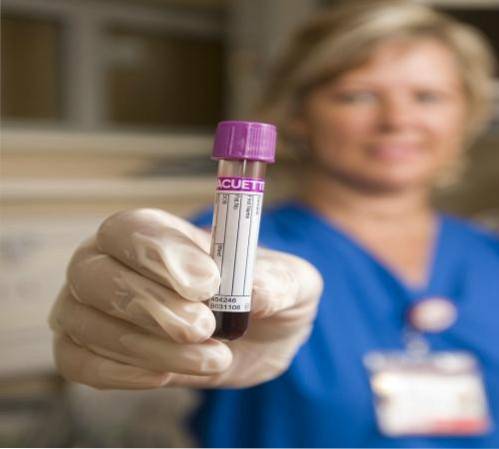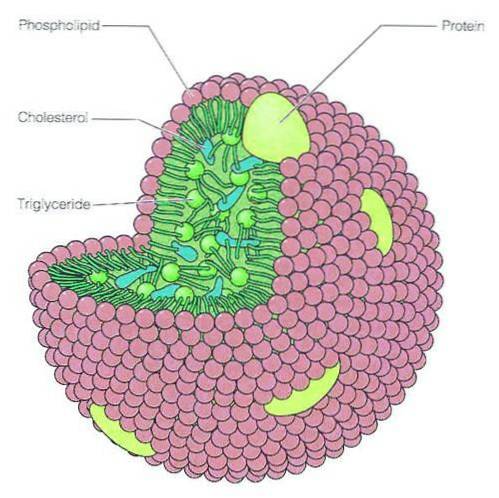
Lipemic Serum Meaning, Causes and Consequences
The lipemic serum It consists of the milky appearance of a laboratory sample due to the high content of plasma fat. The cause of lipemia is the presence of very low-density lipoproteins and triglyceride chylomicrons in plasma. The hydrophobic character of fats produces their suspension in the serum and the characteristic milky appearance of lipemia.
At first glance, a whole blood sample does not show the presence of excess fat molecules. Separation of the serum - for chemical analysis - requires subjecting the sample to centrifugation. When separating the cellular elements, the result is a plasma supernatant whose normal appearance is amber, while the lipemic serum is whitish..

Lipemic serum is a rare finding in the laboratory, approximately less than 3% of samples. This finding will depend on the volume of samples that a laboratory processes. Among the causes of high blood lipid content are dyslipidemias, inadequate fasting prior to taking a sample or the effect of drugs.
The importance of serum lipemia lies in the alterations it produces in routine analysis. Analytical interference is a consequence that occurs in a sample saturated with lipids. Additionally, the finding of lipemic serum is a predictor of cardiac or cerebrovascular pathologies in patients..
Article index
- 1 Meaning
- 2 Causes
- 2.1 Short interval between intake and sampling
- 2.2 Diseases that produce hyperlipidaemia
- 2.3 Parenteral nutrition
- 2.4 Drugs
- 3 consequences
- 3.1 Mechanisms of analytical interference
- 3.2 Parameters altered by lipemic serum
- 4 References
Meaning

A significant aspect of finding lipemic serum is interference in the laboratory blood test. Analytical interference constitutes an alteration of results due to the characteristics of the sample. Abnormally high serum lipid content causes limitation or error in blood chemistry results.
Lipemia or serum lipemic is the result of high concentrations of lipids in the blood. This causes turbidity or opacity of the blood serum due to the suspension of fatty particles in it; however, not all lipids produce turbidity of the serum. Lipemia is caused by the presence of chylomicrons and very low-density lipoproteins (VLDL).
Chylomicrons have a density of less than 0.96 g / ml, and mostly contain triglycerides. These molecules, together with the long and medium chain VLDL, when found in large quantities, produce lipemia. Molecules such as high and low density cholesterol fractions - HDL and LDL, respectively - do not cause lipemia.
The finding of lipemic serum indicates that some laboratory tests may be altered or erroneous. It is a fact that lipemia is the second cause of analytical interference after hemolysis. Today there are lipemic serum clarification techniques that allow analysis to be carried out without interference..
Causes
The high concentration of lipoproteins in the blood can have several causes. The most common cause of hyperlipoproteinemia and lipemic serum is inadequate fasting prior to sampling.
Some clinical conditions, the administration of medications or parenteral nutrition can cause elevation of blood lipids.
Short interval between intake and sampling
The sample for blood chemical analysis should be taken in the morning, after a 12-hour fast. The reason for this is to obtain results in basal conditions of the organism.
Sometimes this is not fully accomplished. The short period of time between ingestion and sampling can cause elevation of blood lipids.
There are other factors that cause serum lipemic. Ingesting excessive food with high fat content or taking the sample at any time has a significant influence on the quality of the sample and its subsequent result..
In emergencies that require immediate examinations, the ideal conditions for taking the sample are overlooked.
Diseases that cause hyperlipidaemia
Some diseases, such as diabetes mellitus, cause elevated blood lipids. Severe dyslipidemias - especially hypertriglyceridemia - are an obvious but rare cause of lipemic serum. Other diseases that alter the lipid content in the blood are:
- Pancreatitis.
- Hypothyroidism.
- Chronic renal insufficiency.
- Collagenopathies, such as systemic lupus erythematosus.
- Liver cancer or liver cirrhosis.
- Colon cancer.
- Myelodysplastic disorders, such as multiple myeloma.
- Chronic alcoholism.
Parenteral nutrition
Administration of lipid-containing solutions for parenteral nutrition produces hyperlipidaemia. This is because the lipid preparations for nutrition go directly into the bloodstream. The sample for chemical laboratory analysis under these conditions contains high concentrations of lipids.
Drugs
The nature of some pharmaceutical specialties can cause lipemia. Among the drugs that can induce elevated blood lipids are the following:
- Steroids, especially with prolonged use.
- Hormonal preparations, such as estrogenic oral contraceptives.
- Antiretroviral drugs based on protease inhibitors.
- Non-selective β-adrenergic antagonists.
- Anesthetics, such as propofol.
- Anticonvulsant medications.
Consequences
The obvious consequences of a lipemic sample will depend on the mechanisms that produce alteration of parameters are diverse. These mechanisms are called analytical interference and their result is different values from the real ones..
Mechanisms of analytical interference
So far, four mechanisms of analytical interference due to lipemia have been proposed:
Alteration in the proportion of water and lipids
Under normal conditions, the lipid content in serum does not exceed 9% of the total. Lipemic serum can contain between 25 and 30% lipids, decreasing the percentage of serum water. This can alter the results when measuring serum electrolytes..
Interference in spectrophotometry
The spectrophotometer is a device that quantifies a parameter according to its ability to absorb light. This analytical method depends on the reaction, substrate, reagent and wavelength necessary to evidence said reaction..
Lipoprotein molecules absorb light, affecting parameters that require low wavelengths for their analysis. The absorbance and scattering of light caused by fat molecules produces measurement error in parameters such as transaminases and serum glucose.
Sample heterogeneity
The hydrophobic nature of lipids causes the serum to separate into two phases: one aqueous and the other lipid. Hydrophilic substances will be absent in the lipid fraction of the sample while lipophilic substances will be "sequestered" by it..
Lipid clarification or separation techniques
When it is not possible to obtain a sample with a lower concentration of lipids, these are separated. Serum clarification methods include sample dilution, polar solvent extraction, and centrifugation.
Some methods of clearing the samples may cause a decrease in the true value of substances analyzed. This must be taken into account when interpreting the data obtained..
Parameters altered by lipemic serum
Errors as a consequence of analytical interference due to lipemia are expressed as values not adjusted to reality. This alteration may show an artificial elevation or decrease in the value of the parameters studied..
Increased concentration
- Total and fractionated proteins, such as albumin and globulins.
- Bile salts
- Calcium.
- Transferrin and iron binding capacity to its transporter (TIBC).
- Match.
- Magnesium.
- Glycemia.
Decreased concentration
- Sodium.
- Potassium.
- Chlorine.
- Transaminases, such as TGO and TGP.
- Amylases.
- Creatine phospho-kinase or CPK, total and fractional.
- Insulin.
- Lactic dehydrogenase or LDH.
- Baking soda.
It should be noted that some blood tests, such as the hemogram, differential count of leukocytes, platelets and clotting times -PT and PTT- are not altered due to lipemic serum.
An important consideration is that hyperlipidemia occurs due to elevated low-density lipoprotein levels. Hyperlipidemia increases the risk of vascular atherogenicity, heart and cerebrovascular diseases.
The decisions derived from a laboratory analysis are fundamental to establish the treatment of a patient. It is necessary for all laboratory personnel to be aware of the analytical errors resulting from lipemic serum. Both bioanalysts and assistants should educate the patient about the requirements prior to sampling.
The bias or analytical error produced by lipemic serum can lead to unnecessary indications and treatments, even harmful to patients. Responsibility for taking adequate samples involves all health personnel, including doctors and nurses..
References
- Nicolak, N. (Biochem med, 2014). Lipemia: causes, interference mechanisms, detection and management. Recovered from ncbi.nlm.nih.gov
- Engelking, Larry (2015). Chylomicrons. Recovered from sciencedirect.com
- Believe, M .; Landerson, J. (Laboratory medicine, 1983). Analytical error due to lipemia. Recovered from academic.oup.com
- Sen. S .; Ghosh, P .; Ghosh, T.K .; Das, M .; Das, S. (from Journal of biomolecular research & therapeutics, 2016). A study on effect of lipemia on electrolyte measurement by direct ion selective electrode method. Recovered from omicsonline.org
- Editorial team (2016). Tests affected by hemolyzed, lipemic and icteric samples and their mechanism. Recovered from laboratoryinfo.com
- Mainali, S .; Davis, S.R .; Krasowski, M.D. (Practical laboratory medicine, 2017). Frequency and causes of lipemia interference of clinical chemistry laboratory tests. Recovered from sciencedirect.com
- Castaño, J.L .; Amores C. Interferences caused by turbidity (lipemia) in the determination of 14 serum constituents. Clinical chemistry 1989; 8 (5): 319-322
- Saldaña, I.M. (Annals of the Faculty of Medicine, 2016). Interference in the determinations of 24 biochemical constituents in the ADVIA 1800 autoanalyzer, caused by in vitro addition of commercial parenteral nutrition emulsion to a pool of sera. Recovered from scielo.org.pe



Yet No Comments